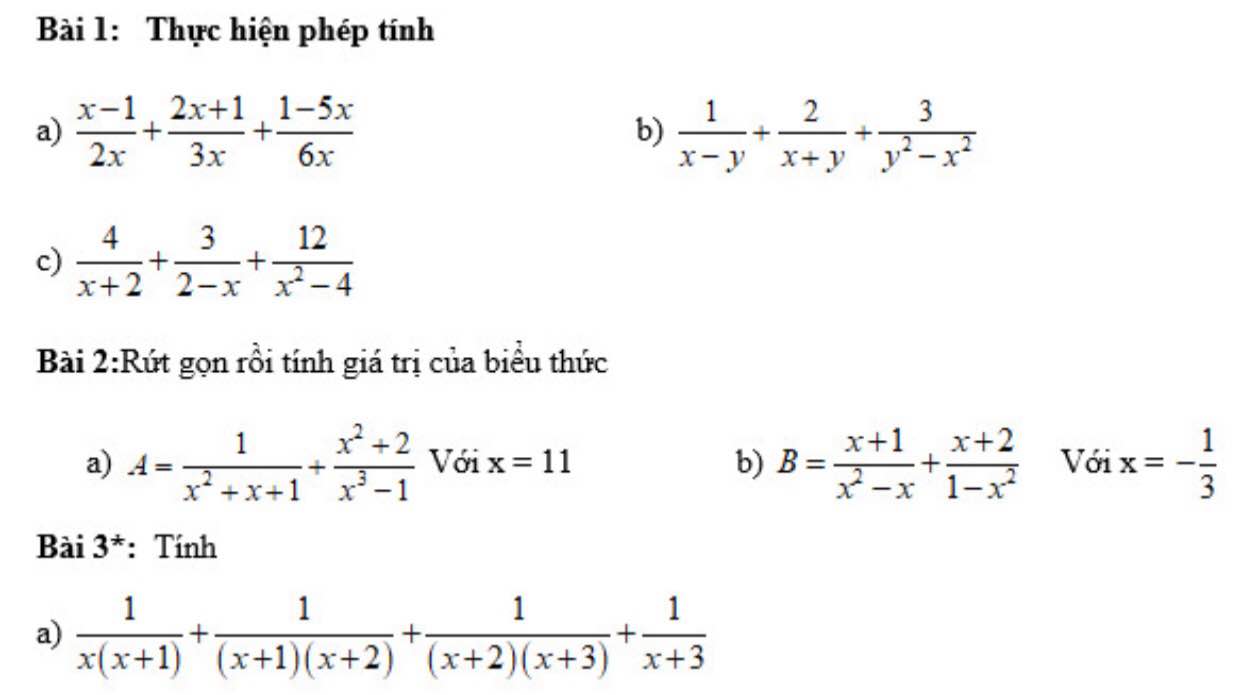
Hãy nhập câu hỏi của bạn vào đây, nếu là tài khoản VIP, bạn sẽ được ưu tiên trả lời.


a) \(x-3=0\)
\(\Leftrightarrow\) \(x=0+3\)
\(\Leftrightarrow\) \(x=3\)
b) \(2x+6=0\)
\(\Leftrightarrow\) \(2x=0-6\)
\(\Leftrightarrow2x=-6\)
\(\Leftrightarrow x=-3\)
c) \(2x+3=x+9\)
\(\Leftrightarrow2x+3-x=9\)
\(\Leftrightarrow x+3=9\)
\(\Leftrightarrow x=9-3\)
\(\Leftrightarrow x=6\)
d) \(\left(x-4\right)\left(2x+4\right)=0\)
\(\Leftrightarrow\left[{}\begin{matrix}x-4=0\\2x+4=0\end{matrix}\right.\)
\(\Leftrightarrow\left[{}\begin{matrix}x=4\\2x+4+\left(-4\right)=0\end{matrix}\right.\)
\(\Leftrightarrow\left[{}\begin{matrix}x=4\\x=-2\end{matrix}\right.\)

3.
Gọi vận tốc xe thứ nhất là x (km/h) với x>0
Vận tốc xe thứ hai là: \(1,2x\) (km/h)
Thời gian xe thứ nhất đi hết quãng đường AB: \(\dfrac{120}{x}\) giờ
Thời gian xe thứ hai đi hết quãng đường AB: \(\dfrac{120}{1,2x}=\dfrac{100}{x}\) giờ
Do xe thứ hai đến sớm hơn xe thứ nhất là 30 phút =1/2 giờ nên ta có pt:
\(\dfrac{120}{x}-\dfrac{100}{x}=\dfrac{1}{2}\)
\(\Rightarrow\dfrac{20}{x}=\dfrac{1}{2}\Rightarrow x=40\) (km/h)
Vậy vận tốc xe thứ nhất là 40 km/h, xe thứ hai là \(40\times1,2=48\) (km/h)
4.
Áp dụng định lý phân giác ta có:
\(\dfrac{IE}{IF}=\dfrac{DE}{DF}=\dfrac{6}{10}=\dfrac{4}{5}\)

a) \(A=3\left(x-1\right)^2-\left(x+1\right)^2+2\left(x-3\right)\left(x+3\right)-\left(2x+3\right)^2-\left(5-20x\right)\)
\(=\left(3x^2-6x+3\right)-\left(x^2+2x+1\right)+2\left(x^2-9\right)-\left(4x^2+12x+9\right)-5+20x\)
\(=-30\)
b) \(B=-x\left(x+2\right)^2+\left(2x+1\right)^2+\left(x+3\right)\left(x^2-3x+9\right)-1\)
\(=-x\left(x^2+4x+4\right)+\left(4x^2+4x+1\right)+\left(x^3-3x^2+9x+3x^2-9x+27\right)-1\)
\(=27\)
a: Ta có: \(A=3\left(x-1\right)^2-\left(x+1\right)^2+2\left(x-3\right)\left(x+3\right)-\left(2x+3\right)^2-\left(5-20x\right)\)
\(=3x^2-6x+3-x^2-2x-1+2x^2-18-4x^2-12x-9-5+20x\)
\(=-30\)
b: Ta có: \(B=-x\left(x+2\right)^2+\left(2x+1\right)^2+\left(x+3\right)\left(x^2-3x+9\right)-1\)
\(=-x^3-4x^2-4x+4x^2+4x+1+x^3+27-1\)
=27

Ta có : y=−13x3+(m−1)x2+(m+3)x−4y=−13x3+(m−1)x2+(m+3)x−4
Có y′=−x2+2(m−1)x+(m+3)y′=−x2+2(m−1)x+(m+3).
Để hàm số nghịch biến trên (0;3)(0;3) thì f′(x)<0∀x∈(0;3)f′(x)<0∀x∈(0;3) nghĩa là :
−x2+2(m−1)x+m+3<0⇔m<x2+2x−32x+1−x2+2(m−1)x+m+3<0⇔m<x2+2x−32x+1 với mọi x∈(0;3)x∈(0;3)
Đến đây ta chỉ việc tìm cực tiểu của hàm số f(x)=x2+2x−32x+1f(x)=x2+2x−32x+1 trên (0;3)(0;3).
Dễ dàng chứng minh f(x)f(x) đồng biến nên f(x)>f(0)=−3f(x)>f(0)=−3.
Vậy m≤−3m≤−3.
------------------------------------------
P/S:Ko chắc 

a: Xét ΔABC có
M là trung điểm của AB
N là trung điểm của AC
Do đó: MN là đường trung bình của ΔBAC


Bài 1:
\(a,=\dfrac{3x-3+4x+2+1-5x}{6x}=\dfrac{2x}{6x}=\dfrac{1}{3}\\ b,=\dfrac{x+y+2x-2y-3}{\left(x-y\right)\left(x+y\right)}=\dfrac{3x-y-3}{\left(x-y\right)\left(x+y\right)}\\ c,=\dfrac{4x-8-3x-6+12}{\left(x-2\right)\left(x+2\right)}=\dfrac{x-2}{\left(x-2\right)\left(x+2\right)}=\dfrac{1}{x+2}\)
Bài 2:
\(a,A=\dfrac{x-1+x^2+2}{\left(x-1\right)\left(x^2+x+1\right)}=\dfrac{1}{x-1}=\dfrac{1}{11-1}=\dfrac{1}{10}\\ b,B=\dfrac{x^2+2x+1-x^2-2x}{x\left(x-1\right)\left(x+1\right)}=\dfrac{1}{x\left(x^2-1\right)}=\dfrac{1}{\left(-\dfrac{1}{3}\right)\left(\dfrac{1}{9}-1\right)}=\dfrac{27}{8}\)
Bài 3:
\(a,=\dfrac{1}{x}-\dfrac{1}{x+1}+\dfrac{1}{x+1}-\dfrac{1}{x+2}+\dfrac{1}{x+2}-\dfrac{1}{3+x}+\dfrac{1}{x+3}=\dfrac{1}{x}\)











Bài 2:
a: \(201^3=8120601\)
b: \(199^3=7880599\)
c: \(52^3-8=140600\)
d: \(23^3-27=12140\)
e: \(99^3=970299\)
f: \(62\cdot58=3596\)
Bài 1:
a: \(\left(2x+y\right)^2-\left(y-2x\right)^2\)
\(=4x^2+4xy+y^2-y^2+4xy-4x^2\)
=8xy
b: \(\left(5x+5\right)^2+10\cdot\left(x-3\right)\left(x+1\right)+x^2-6x+9\)
\(=\left(5x+5\right)^2+2\cdot\left(5x+5\right)\cdot\left(x-3\right)+\left(x-3\right)^2\)
\(=\left(6x+2\right)^2\)
\(=36x^2+24x+4\)
c: \(\left(x-y\right)^3+3xy\left(x-y\right)\)
\(=x^3-3x^2y+3xy^2-y^3+3x^2y-3xy^2\)
\(=x^3-y^3\)
d: \(\left(1-2x\right)\left(1+2x+4x^2\right)+8\left(x-1\right)\left(x^2+x+1\right)\)
\(=1-8x^3+8\left(x^3-1\right)\)
\(=1-8x^3+8x^3-8\)
=-7